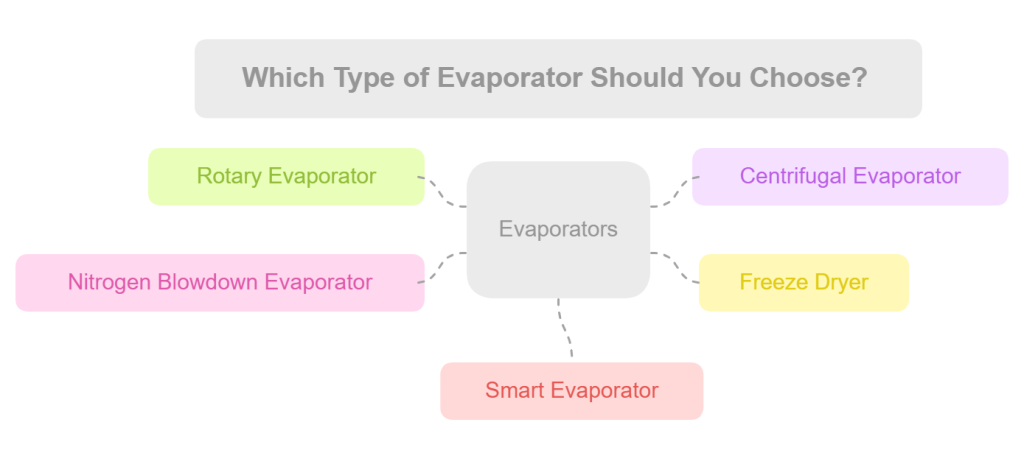Latest Trends in Evaporation Technology: What Equipment Will Laboratories Need in the Future?

Table of Contents
- 1. Introduction: The Evolution of Evaporation Technology in Laboratories
- 2. Latest Trends in Evaporation Technology and Comparison
- 3. Conclusion: Selecting the Best Evaporation System for Your Laboratory
(The Illustration Author:storyset/Freepik)
Ready for Safer, Faster, and More Reliable Evaporation?
1. Introduction: The Evolution of Evaporation Technology in Laboratories
Evaporation and drying processes are essential in research and development laboratories. However, advancements in technology have led to significant improvements in energy efficiency, operational efficiency, and automation, thereby providing laboratories with more diverse and effective options.
In this article, we will introduce the latest trends in evaporation technology and compare five major types of evaporators so that laboratories can select the most suitable equipment for their needs.
- Rotary Evaporator
- Centrifugal Evaporator
- Nitrogen Blowdown Evaporator
- Freeze Dryer
- VVC Evaporator (Smart Evaporator)
2. Latest Trends in Evaporation Technology and Comparison
2-1. Energy Efficiency and Environmental Impact
Reducing energy consumption in evaporation processes is crucial not only for cost reduction but also for environmental sustainability. Therefore, laboratories must carefully consider energy-efficient equipment to minimize their carbon footprint. To provide a clearer perspective, below is a comparison of the energy efficiency of different evaporation methods.
Ready for Safer, Faster, and More Reliable Evaporation? Download Now
2-2. High Efficiency vs. Workload Reduction
When choosing an evaporator, it is essential to balance processing speed and workload. While some evaporators provide rapid evaporation, they often require extensive manual intervention. Conversely, others may reduce workload but take longer to process samples. To help clarify, the following table compares how different evaporators perform in terms of speed and labor intensity.
2-3. Automation for Increased Operational Efficiency
As laboratory automation becomes more prevalent, reducing manual intervention while simultaneously improving reproducibility has become a crucial requirement. Given these developments, below is a comparison of automation capabilities across different evaporators.
| Types of Evaporators | Level of Automation |
| Rotary Evaporator | Limited automation. Unattended operation may be possible with optional modules for continuous solvent supply and discharge, although this is still mostly experimental and not widely adopted. |
| Centrifugal Evaporator | Limited automation. Some automation features have been implemented, and in recent years, new models have started to emerge aiming for fully automated workflows, though such solutions are not yet common. |
| Nitrogen Blowdown Evaporator | Partial automation with timer control and gas flow management. However, manual adjustment is still required for most operations. |
| Freeze Dryer | Limited automation. Automation efforts have been made, and fully automated models have started to appear; however, full automation of evaporation and drying is still seen as challenging in practice. |
| Smart Evaporator (VVC method evaporator) | Semi-automated, which means that it requires no constant monitoring for efficient operation. However, full automation is available with Auto Multi 140*. |
*Smart Evaporator Auto Multi 140: Fully Automated Multi-Sample Evaporation
The Auto Multi 140, a fully automated model of the Smart Evaporator, is a ultimate solution that eliminates manual intervention.
- Notably, it handles multiple samples simultaneously, increasing throughput.
- In addition, its fully automated operation allows researchers to focus on other tasks.
- Furthermore, it maintains the benefits of VVC evaporation technology, such as no bumping risk and energy efficiency.
- Thanks to its high processing speed and semi- to fully-automated control, it supports efficient workflows even for high-boiling solvents.
Ready for Safer, Faster, and More Reliable Evaporation? Download Now
3.Conclusion: Selecting the Best Evaporation System for Your Laboratory

Advancements in evaporation technology have provided laboratories with a diverse range of systems tailored to specific needs. While automation continues to advance in some areas, many researchers still consider the evaporation process difficult to fully automate. Although certain models and features aim to reduce manual intervention, complete automation remains limited in most practical settings.
By carefully evaluating energy efficiency, processing speed, workload, and the level of automation support, laboratories can choose evaporation systems that best match their research goals and working styles. Below is a summary of recommended applications for each evaporator type:
- For high-volume, fast evaporation: The Rotary Evaporator offers strong performance for large-scale solvent removal but requires attentive operation.
- For temperature-sensitive biological samples: The Centrifugal Evaporator or Freeze Dryer are ideal due to their gentle processing conditions. Some models offer partial automation, though hands-on management is still common.
- For moderate-speed, multi-sample processing: The Nitrogen Blowdown Evaporator is widely used but often labor-intensive.
- For high-speed evaporation of high-boiling solvents with reduced workload: The Smart Evaporator (VVC method) provides a semi-automated, energy-conscious solution with minimal risk of bumping.
- For laboratories exploring automated workflows: The Smart Evaporator Auto Multi 140 offers full automation for multi-sample evaporation, though it is still a relatively new option and not yet widely adopted.
By selecting the evaporator that fits their specific operational needs, laboratories can achieve more efficient, reproducible, and sustainable workflows—while adapting to the evolving landscape of evaporation technology.
Ready for Safer, Faster, and More Reliable Evaporation? Download Now
